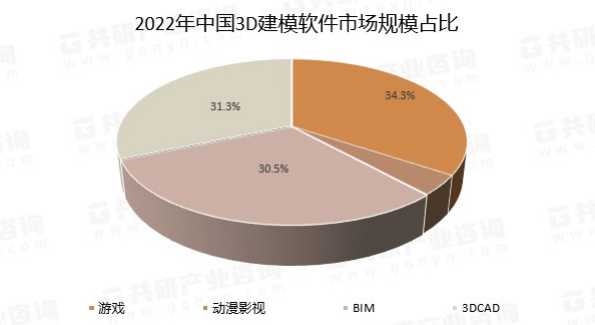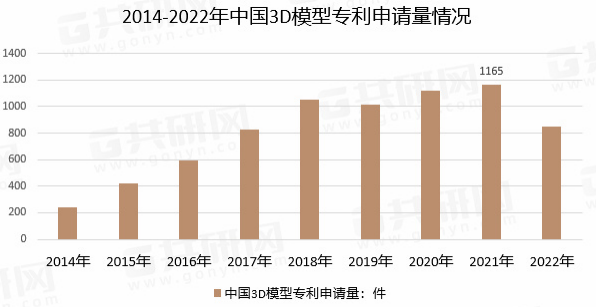
Image Source: Generated by Wujie AI
With the continuous development of technology and the entertainment industry, 3D modeling has become a popular profession in today's society. From game design, film and television production to the metaverse and other fields, 3D modelers play a crucial role in various industries.
The 3D modeling market is a promising industry, and China is no exception. With the continuous advancement of technology and the increasing demand for high-quality 3D modeling in various industries, the 3D modeling market in China is developing rapidly.
This article aims to provide a comprehensive analysis of the domestic 3D modeling market, including market size, trend growth, competitive landscape, key driving factors, and future prospects. Through in-depth research, we can better understand the current situation and potential opportunities in this market.
Current Status of the Global 3D Modeling Market
In order to enhance the viewing experience in mobile applications, games, and digital entertainment, there is a high demand for 3D models. One of the hottest trends in the field of 3D model technology is VR integration, and an increasing number of enterprises are realizing the practical application of this technology. 3D models are widely used in various industries such as architecture, automotive, transportation, healthcare, and entertainment. The emergence of 3D models has promoted the accuracy of artificial intelligence and machine learning technologies. 3D models can shorten the product development cycle time and reduce trial and error costs.
According to QYR (Hengzhou Bozhi) statistics and forecasts, the global 3D modeling market sales reached 993.14 million US dollars in 2021, and it is expected to reach 1,978.31 million US dollars by 2028, with a compound annual growth rate (CAGR) of 10.76% (2022-2028).
From a regional perspective, the Chinese market has undergone rapid changes in recent years. The market size in 2021 was 134.64 million US dollars, accounting for approximately 13.56% of the global market, and it is expected to reach 338.48 million US dollars by 2028, at which point the global share will reach 17.11%.
At the regional level, North America is currently the largest market globally, with a market share of 37.04% in 2021, followed by Europe and China, accounting for 31.17% and 13.56% respectively. It is expected that the Chinese region will experience the fastest growth in the coming years, with a CAGR of approximately 13.66% from 2022 to 2028.
In terms of product types, 3ds Max models hold an important position, and it is estimated that their market share will reach 23.41% by 2028. In terms of applications, the share of film and television was approximately 23.60% in 2021, with a CAGR of approximately 9.44% in the coming years.
From an enterprise perspective, globally, the core manufacturers of 3D models mainly include TurboSquid (Shutterstock), Sketchfab (Epic Games), CGTrader, Envato, and 3DSkyHost. In 2021, the leading global manufacturers were mainly TurboSquid (Shutterstock), Unity Asset Store, and Sketchfab (Epic Games), collectively accounting for 45.13% of the market share.
Current Status of the Domestic 3D Modeling Market
The 3D modeling technology in China continues to develop under the guidance of government policies. The government has identified 3D industry technology as a key development area and has increased support for technology and industry. Government-supported policies and investments have driven the widespread application of 3D technology and promoted the development of 3D modeling. It is expected that the market size of China's 3D modeling software will grow by 12.9% year-on-year by 2023.

3D modeling software is currently mainly used in the industrial, architectural, animation and gaming industries. The entertainment sector is the main driving force for the growth of China's 3D modeling software market. In the future, driven by the concept of the metaverse and Chinese government policies, the Chinese 3D modeling software industry will accelerate its expansion.

With the rapid development of computer technology in recent years, the research and application of 3D technology has gone through decades of preliminary exploration. Significant breakthroughs have been made in the maturity, completeness, ease of use, user-friendliness, and cost-effectiveness of the technology. From 2014 to 2022, the number of 3D model patent applications in China showed a growing trend, totaling 7,276.

The Chinese 3D modeling market exhibits regional differences, with major market areas including first-tier cities such as Beijing, Shanghai, Shenzhen, and developed manufacturing regions such as Guangdong and Zhejiang. First-tier cities enjoy a leading position in the application and research and development of 3D modeling technology, while manufacturing hubs require a large amount of 3D modeling to support product design and manufacturing.
In terms of the industrial chain structure, the industrial chain structure of the 3D modeling industry includes digital model design, digital processing, and post-processing. Among them, digital model design is the core link of 3D modeling, and digital processing and post-processing are important links in transforming digital models into actual products. Different companies and teams exist in different links of the industrial chain, and the competitive landscape is relatively dispersed.
From the perspective of competitive landscape, there are multiple well-known companies in the domestic 3D modeling industry, such as Autodesk, Unity, Blender, and others. These companies have strong capabilities and technological advantages in digital model design, digital processing, and post-processing. In addition, there are also some small 3D modeling companies that occupy a certain market share in the industry through continuous learning and innovation.
With the continuous increase in user demand, the market demand for the 3D modeling industry is also continuously increasing. Users have increasingly higher requirements for 3D modeling, not only needing accurate model details but also requiring higher interactivity and immersion. At the same time, as 3D modeling technology continues to develop, user demands for 3D modeling are also constantly changing.
Application Scenarios of 3D Modeling Technology
Game Development: In game development, 3D scene modeling is used to create various game world scenes, including city streets, indoor scenes, natural environments, and more. Through detailed modeling, texturing, and rendering, it can present players with a realistic and immersive game world.
Film and Television Production: In the process of film, television, and animation production, 3D scene modeling is used to create background scenes and special effects. Through modeling and rendering, it can create visually impactful and artistic scenes, enhancing the expressive power of the story.
Architectural Design and Visualization: In the construction industry, 3D scene modeling is used for architectural design and visualization, helping architects and designers better present design schemes. Through modeling and rendering, realistic building appearances, interior layouts, and landscape environments can be created for more accurate evaluation and communication.
VR and AR: 3D scene modeling is also widely used in virtual reality and augmented reality technologies. Through modeling and rendering, it can create virtual three-dimensional environments for users to interact and merge with the real world, providing an immersive experience.
Development Trends and Prospects of the 3D Modeling Industry
In terms of technological innovation, with the continuous development of 3D modeling technology, new technologies and tools continue to emerge. In the future, 3D modeling technology will become more refined, automated, and intelligent, further improving the efficiency and quality of modeling.
In terms of digital transformation, as the level of enterprise digitization increases, the 3D modeling industry will gradually undergo digital transformation. Digital transformation can improve the efficiency and quality of enterprises, while also enhancing user experience.
Policy support is also an important development trend for the 3D modeling industry. With the country's emphasis on and support for the digital economy, the 3D modeling industry will receive more policy support. Policy support can promote industry development and enhance the competitiveness of enterprises.
China's 3D modeling market is a vibrant and promising industry, driven by technological innovation, manufacturing industry upgrades, and government support. Various sub-markets and participants are constantly striving to meet customer needs, while also facing fierce competition. However, with the continuous advancement of technology and the expansion of the market, China's 3D modeling market will continue to thrive, providing rich opportunities and prospects for investors, entrepreneurs, and policymakers.
免责声明:本文章仅代表作者个人观点,不代表本平台的立场和观点。本文章仅供信息分享,不构成对任何人的任何投资建议。用户与作者之间的任何争议,与本平台无关。如网页中刊载的文章或图片涉及侵权,请提供相关的权利证明和身份证明发送邮件到support@aicoin.com,本平台相关工作人员将会进行核查。




